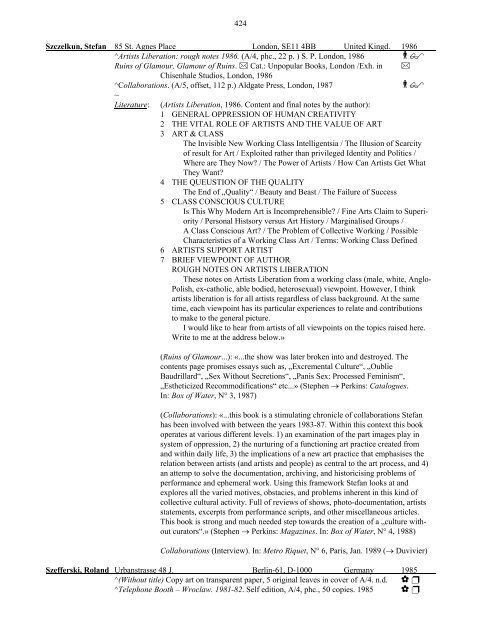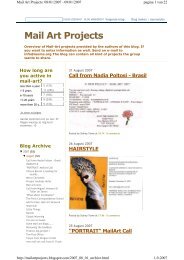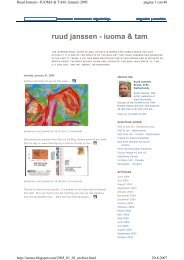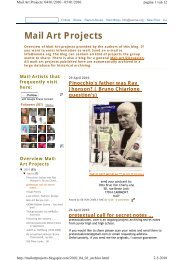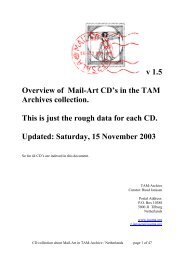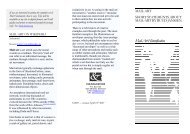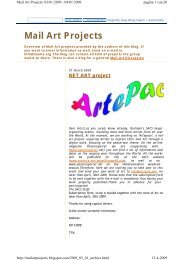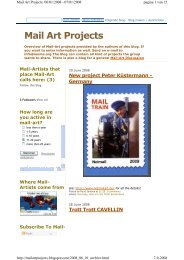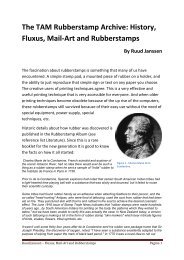424Szczelkun, Stefan 85 St. Agnes Place London, SE11 4BB United Kingd. 1986^Artists Liberation: rough notes 1986. (A/4, phc., 22 p. ) S. P. London, 1986 Ruins of Glamour, Glamour of Ruins. Cat.: Unpopular Books, London /Exh. in Chisenhale Studios, London, 1986^Collaborations. (A/5, offset, 112 p.) Aldgate Press, London, 1987 ~Literature: (Artists Liberation, 1986. Content and final notes <strong>by</strong> the author):1 GENERAL OPPRESSION OF HUMAN CREATIVITY2 THE VITAL ROLE OF ARTISTS AND THE VALUE OF ART3 ART & CLASSThe Invisible New Working Class Intelligentsia / The Illusion of Scarcityof result for Art / Exploited rather than privileged Identity and Politics /Where are They Now? / The Power of Artists / How Can Artists Get WhatThey Want?4 THE QUEUSTION OF THE QUALITYThe End of „Quality“ / Beauty and Beast / The Failure of Success5 CLASS CONSCIOUS CULTUREIs This Why Modern Art is Incomprehensible? / Fine Arts Claim to Superiority/ Personal Histsory versus Art History / Marginalised Groups /A Class Conscious Art? / The Problem of Collective Working / PossibleCharacteristics of a Working Class Art / Terms: Working Class Defined6 ARTISTS SUPPORT ARTIST7 BRIEF VIEWPOINT OF AUTHORROUGH NOTES ON ARTISTS LIBERATIONThese notes on Artists Liberation from a working class (male, white, Anglo-Polish, ex-catholic, able bodied, heterosexual) viewpoint. However, I thinkartists liberation is for all artists regardless of class background. At the sametime, each viewpoint has its particular experiences to relate and contributionsto make to the general picture.I would like to hear from artists of all viewpoints on the topics raised here.Write to me at the address below.»(Ruins of Glamour...): «...the show was later broken into and destroyed. Thecontents page promises essays such as, „Excremental Culture“, „OublieBaudrillard“, „Sex Without Secretions“, „Panis Sex: Processed Feminism“,„Estheticized Recommodifications“ etc...» (Stephen → Perkins: Catalogues.In: Box of Water, N° 3, 1987)(Collaborations): «...this book is a stimulating chronicle of collaborations Stefanhas been involved with between the years 1983-87. Within this context this bookoperates at various different levels. 1) an examination of the part images play insystem of oppression, 2) the nurturing of a functioning art practice created fromand within daily life, 3) the implications of a new art practice that emphasises therelation between artists (and artists and people) as central to the art process, and 4)an attemp to solve the documentation, archiving, and historicising problems ofperformance and ephemeral work. Using this framework Stefan looks at andexplores all the varied motives, obstacies, and problems inherent in this kind ofcollective cultural activity. Full of reviews of shows, photo-documentation, artistsstatements, excerpts from performance scripts, and other miscellaneous articles.This book is strong and much needed step towards the creation of a „culture withoutcurators“.» (Stephen → Perkins: Magazines. In: Box of Water, N° 4, 1988)Collaborations (Interview). In: Metro Riquet, N° 6, Paris, Jan. 1989 (→ Duvivier)Szefferski, Roland Urbanstrasse 48 J. Berlin-61, D-1000 Germany 1985^(Without title) Copy art on transparent paper, 5 original leaves in cover of A/4. n.d. ^Telephone Booth – Wroclaw. 1981-82. Self edition, A/4, phc., 50 copies. 1985
425^The Forgotten Language – Berlin '85. Xerographical work in size of A/4, 8 leaves,+ silver cover. 1985 Székely, Ákos→ Leopold BloomSzkárosi, Endre / Garaczi, László. Váci út 34. Budapest, H-1132 Hungary 1988Új Hölgyfutár (Info mag. with vis. poetry & graphic, A/5, offset, 8 p. 1988- 92, qu.) ^Intermámor '88. Muusalliance Transactiviste. (with → Galántai) Cat.: Cut A/4,offset, 28 p. / Club M. M., Almássy tér, Budapest. paril 16, 1988 Szombathy, Bálint Rade Koncara 52 Sremsra-Kamenica, YU-21208, Yugoslavia 1982↑ Save Vukovica 18 Novi Sad, YU-21000 1977↑ Zeljeznicka 14. Novi Sad, YU-21000 1971.............................................................................................................................................................^Underground Elevator (with → Szombathy, Bálint) (Folio magazine like assembl- ing with typewritten matter, handmade drawings and mimepgr.A/4 leaves in a cover of 52x32.5 cm. {40 & 15}, 1971-72, #1-2)Mixed Up Underground (with Attila Csernik) (Assembling for A/4 and A/5 matter, mostly typewritten sheets, in a portfolio of 51x37 cm. {30}1972, #1)^Kontaktor (with → Szombathy, Bálint) (An early assembling in envelope of 23x35 cm. with ~20 leaves each issue, vis. and exp. poetry and image matter.1972-73, #1-2) Edition Group Bosch + Bosch^FLUXUS. Visual literature, in a brochure edited with → Tóth, G. & → Zagoricnik, A/5, offset, 12 p. Experimental Art Publisher. Bohinj YU, 1973^WOW (with → Matkovic, Slavko / Group Bosch + Bosch) (Post-fluxus and Mail Art ®magazine in var. size and contains. 1974-80, #1-6)N°1, A4 size magazine {45}, 1974N°2, 30x41.5 cm, four colour silk screen {150}, 1974N°3, 50x18 cm, folded, offset {210}, 1975N°4, 30,5x45 cm, offset, info, Yug. & Hung. altern. art scene, 1975N°5, 50x18 cm, 4 sheets r/v., int. issue, Würzburg {300}, 1976N°6, 2 oversize sheets with orig. rubber stamps {120}, 1980^#1, 3, 4, 5, 6^Poetical Objects of the urbanical Environment. (with works <strong>by</strong> B. Szombathy, F. → Zagoricnik, Katalin Ladik, Gábor → Tóth) A/5, offset, 16 p.in cover or envelope. Experimental Art Publisher, Budapest -Novi Sad. 1976^Rubberstamps (Project in 1979, with orig. stamps, publ. in: WOW, N° 6, 1980.) ® ^Artists who use pseudonyms (in the network) (Hungarian publ. in: Új Symposion, #183-184, 1980 & Híd, #2-3, 1982, 210-224 & 337-350 p.)^Poetry. Concrete Visual Poems 1969-1979. (Book, 27x20.5 cm., offset, 128 p. Texts: Hungarian, English, Serbian) Ed. Forum, Novi Sad, 1981^Illustrated history of art. (Letter size publ. about spirits-posters, phc., 28 leaves,limited ed.) Centre de Recherche Neoiste, Outremont, 1981Art in the bed (with→ Shimamoto) Doc. in: AU #66 Exh.: 25. Maj. Gallery. Novi Sad / Multimedia Center, Zagreb, 1984^Müvészek és müvészetek («Artists and Arts». From suprematism to Mail Art. 23x 17 cm., offset/colour, 80 p. Hungarian, ) Ed. Forum, Novi Sad, 1987^Új idök, új müvészet («New Times, New Arts». About div. forms of experimentaleart in Yugoslavia. 23x17 cm., offset, 130 p. Hungarian), Ed. Forum,Novi Sad, 1991~Literature: ^Szombathy, Bálint, → Tóth, Gábor, → Konieczny, Marek, and others: Alternativenin der sozialistischen Kunstproduktion. (About the special trait of the EasternEuropean Conceptual / Alternative / Mail Art). Translated into German and published<strong>by</strong> Klaus → Groh in the form of a A/4 flyer, instant print, 4 p. 1976
- Page 1 and 2:
Géza PerneczkyNETWORK ATLASWorks a
- Page 3 and 4:
317Oberholzer, Christoph Turbinenha
- Page 5 and 6:
31968 p., Exh.: Gesamthochschule, M
- Page 7 and 8:
321(5x) in plastic box {999}. Tiege
- Page 9 and 10:
323Über das Dichtertum für J. O.
- Page 11 and 12:
325drawings, 32 p.Pat → Fish: Nin
- Page 13 and 14:
327front of each copy, so each rece
- Page 15 and 16:
329^Tema y variaciones. (Colletive
- Page 17 and 18:
331denouncing the suppression of hu
- Page 19 and 20:
333!Panpost! → Bloch, Mark S.Pap,
- Page 21 and 22:
335Literature:«Coop mail art proje
- Page 23 and 24:
337(France), Klaus Groh (Germany),
- Page 25 and 26:
339^Forty Six. Instruments of Desir
- Page 27 and 28:
341formed as postcards or «letters
- Page 29 and 30:
343^# N°5-6 (1978), N°7 (1978), N
- Page 31 and 32:
345(John Held Jr.: Assembling Perio
- Page 33 and 34:
347^ME (Edited by !Pittore Euforico
- Page 35 and 36:
349«...I began my Network mail art
- Page 37 and 38:
351~Source:Literature:print on whit
- Page 39 and 40:
353with an interest for the undergr
- Page 41 and 42:
355our five senses. Along with tast
- Page 43 and 44:
357Muzeum Sztuki Aktualnej, Kraków
- Page 45 and 46:
359Pütz, Claudia PIPS, Dada-Corpor
- Page 47 and 48:
361page with green paper. Additiona
- Page 49 and 50:
363GDR with essays, catalogues and
- Page 51 and 52:
3658 Portraits - suicide graphique
- Page 53 and 54:
367Robakowski, Joseph Ul. Mickiewic
- Page 55 and 56:
369& concept art, also assembling i
- Page 57 and 58:
371^# 1/1, 2; 2/1, 2, 3; 3/1; 4/II.
- Page 59 and 60: 373^The Risk. Cutted Fragments of N
- Page 61 and 62: 375centralized mail art congress as
- Page 63 and 64: 377was the concept of this magazine
- Page 65 and 66: 379Rutkovsky, Paul / Cutrell, Fran.
- Page 67 and 68: 381S:t Petri, Galerie→ Sellem, Je
- Page 69 and 70: 383Sarenco, Amodulo Calaone Baone (
- Page 71 and 72: 385/ Russian. Ed. Gertraud Scholz,
- Page 73 and 74: 387(About Smirk /Smile #4): «...Th
- Page 75 and 76: 389The Bremen-Kassel Connection (A
- Page 77 and 78: 391Roy Adzak: Screws (Object book,
- Page 79 and 80: 393NEUES MUSEUM WESERBURG BREMEN.(T
- Page 81 and 82: 395Schwerin: Staatliches Museum^Mai
- Page 83 and 84: 397^Mail Art Puzzle Project. ongio
- Page 85 and 86: 399«Seul, Kwan Hoon Museum», Seul
- Page 87: 401^Gorbachev / Gorbi, Mail Art Pro
- Page 90 and 91: 404^happening & fluxus (Edited by H
- Page 92 and 93: 406*R. Thomas, W. Ting, **B. Watts,
- Page 94 and 95: 408haeadquartier's lobby during Feb
- Page 96 and 97: 410Art competitions, music. Stateme
- Page 98 and 99: 412Géza Perneczky: The Magazine Ne
- Page 100 and 101: 414Stempelplaats Editions:→ Banan
- Page 102 and 103: 416(Fashion, #1): «... features wo
- Page 104 and 105: 418^Il Granaio / Pittura - Mostra a
- Page 106 and 107: 420^Soviet & Eastern European Mail
- Page 108 and 109: 422Magazines. International Network
- Page 112 and 113: 426(WOW and other publications from
- Page 114 and 115: 428[→ Hoffberg], Vol. 3, #1, 17 p
- Page 116 and 117: 430Thurner, Hans→ Lechner, UteTif
- Page 118 and 119: 432of potentially interested paprti
- Page 120 and 121: 434(...)As you might know the inter
- Page 122 and 123: 436this new series has been numbere
- Page 124 and 125: 438points to the signalism sources
- Page 126 and 127: 440voor mij onmiddelijk een van de
- Page 128 and 129: 442190182 (untitled). The fanzine
- Page 130 and 131: 444{100}.140686 COPYING TOYS. Actio
- Page 132 and 133: 446Tron, Otto ? River Fall, WI USA
- Page 134 and 135: 448^#1-17Luther → Blissett & Stew
- Page 136 and 137: 4501973. 1 p.)Géza Perneczky: The
- Page 138 and 139: 452Vancouver East Culture Centre, O
- Page 140 and 141: 454~Source:~Literature:audio & visu
- Page 142 and 143: 456as a nostalgic joint. (...)With
- Page 144 and 145: 458Vitale, Angelo Via Settembrini 2
- Page 146 and 147: 460perimental literature [also some
- Page 148 and 149: 462^Every Woman is a Gentleman. Doc
- Page 150 and 151: 464already transforming as the ethe
- Page 152 and 153: 466Wien, A-1080), 1989^Mail Art Por
- Page 154 and 155: 468Klaus Werner (1978): Künstlelrp
- Page 156 and 157: 470Wozniak, Ryszard Ul. Spolska 5.
- Page 158 and 159: 472Strategic for Wracking Hylic. (1
- Page 160 and 161:
474amson...»(Lightworks [→Burch]
- Page 162 and 163:
476Univer sity of Chicago and read
- Page 164 and 165:
478Zerpa, Carlos Urb. Los Sauces, C
- Page 166 and 167:
482A P P E N D I X(General bibliogr
- Page 168 and 169:
484°Rutkovsky, Paul: Visual Satire
- Page 170 and 171:
486→ Perneczky, G.: The Story of
- Page 172 and 173:
488Periodics by Original Graphics b
- Page 174 and 175:
490Radlov, Sergej: Kurze Einführun
- Page 176 and 177:
492Model Peltex. 3 rue des Couples.
- Page 178 and 179:
494United States of Mind = Anna Ban
- Page 180 and 181:
496Art. Contemporary Art Press (→
- Page 182 and 183:
498→ Guy Bleus: Philately: Mail A
- Page 184 and 185:
500I Cardona, Carolee Schneemann, A
- Page 186 and 187:
502→ MacLeod, Scott: Art Strike.
- Page 188 and 189:
504→ Dunn, Lloyd: Editorial. (For
- Page 190 and 191:
506Objeto Biografico. 21x31 cm., xe
- Page 192 and 193:
508^Copy Art. Trocken schreiben - i
- Page 194 and 195:
510Les lignes brisées.Le panier de
- Page 196 and 197:
512→^Banana, Anna: About VILE (Le
- Page 198 and 199:
514→^Ruch, Günther: Mail Art Con
- Page 200 and 201:
516Karol Sauerland: On the Latitude
- Page 202 and 203:
518Press, London, 1988. Tetxts by K
- Page 204 and 205:
520The Curch of the SubGenius, Dall
- Page 206 and 207:
522LOUISE LITSZActor and singer, me
- Page 208 and 209:
524Mail Art) In: The Magazine Netwo
- Page 210 and 211:
526→ Kocman, J. H.: Stamp Activit
- Page 212 and 213:
528→ Vigo, E. A.: Small Creative
- Page 214 and 215:
530offset, 16 p. {500} In: Ed. «co
- Page 216 and 217:
532*Abracadada - Box 210367. San Fr
- Page 218 and 219:
534AustraliaSMIRK #1 by «Sam Monk
- Page 220 and 221:
536SMILE by Vittore Baroni (unique
- Page 222 and 223:
538«Suicide» as a Network Idea→
- Page 224 and 225:
540konkrete poëzie? / concrete poe
- Page 226 and 227:
542offset / colour, 144 p. Galerie
- Page 228 and 229:
544Tischkov) In: ersichtlichkeiten,
- Page 230 and 231:
Acuse de recibo (Mail Art project w
- Page 232 and 233:
548And / „&“ (Mail Art project,
- Page 234 and 235:
550Art is Books (exh. at the Centr.
- Page 236 and 237:
552Artists' Books, Permanent Collec
- Page 238 and 239:
554Audio Mail Art: Introvision (inf
- Page 240 and 241:
Big Art (1 km², concpetual publ. o
- Page 242 and 243:
558Bric a Brac (Mail Art zine, anno
- Page 244 and 245:
Cella n. 27851, (Mail Art exh., 198
- Page 246 and 247:
562Commodity Character (Photoreport
- Page 248 and 249:
564„Cosey Fanni Tutti“ (artist
- Page 250 and 251:
„Dazar“ / „Omahaha“ / „Po
- Page 252 and 253:
568Drucksache (Mag. with poetry, gr
- Page 254 and 255:
Envelope and its Contents (Mail Art
- Page 256 and 257:
572Fast-Lift Mail Art Project (1994
- Page 258 and 259:
574Fluxu Action #1 - incongruous me
- Page 260 and 261:
576General Idea (eds.): FILE magazi
- Page 262 and 263:
„Harlekin Art“ (post-Fluxus, Ma
- Page 264 and 265:
580I Support the Postal Workers (Co
- Page 266 and 267:
582Int. Mail Art Exh. (at the Postk
- Page 268 and 269:
Kepler (Mail Art prj., Wendelinskap
- Page 270 and 271:
Laughing Bear - Newsletter (Magazin
- Page 272 and 273:
588Luna Bisonte Prods. / Lost and F
- Page 274 and 275:
Mail etc. Art (exh. at the Universi
- Page 276 and 277:
mEINBLICK (Mail Art at the Gal. im
- Page 278 and 279:
594(Moon Faces:) The Springfullmoon
- Page 280 and 281:
596Neoist Para-Festival - APT '80 (
- Page 282 and 283:
Obscurities - Mail Art / Missing Do
- Page 284 and 285:
P. S. (Tabloid for the int. perform
- Page 286 and 287:
602Photography thematical postcards
- Page 288 and 289:
Positiv-Negativ (Commonpress #8, 19
- Page 290 and 291:
606Prison, Today Art is a... (Mail
- Page 292 and 293:
Recycling Mail (assembled matterial
- Page 294 and 295:
610Newspaper: The Stampa / (Inv. to
- Page 296 and 297:
612Season's Greetings (Mail Art prj
- Page 298 and 299:
Sky Views Magazine (new and alterna
- Page 300 and 301:
616Stamp Art (offset cat. for the c
- Page 302 and 303:
618Synapse, Visual Art Press for Ar
- Page 304 and 305:
Timbro d'Artista (Mail Art project
- Page 306 and 307:
622Un Regard Moderne (tabloid size
- Page 308 and 309:
624Visual Poetry 1985-1995 (exh. at
- Page 310 and 311:
626WO. Visuella Poesie in Berlin (l
- Page 312 and 313:
628Zeitschrift für alles - Review
- Page 314 and 315:
ABBREVIATIONSMagazines: m. = monthl


